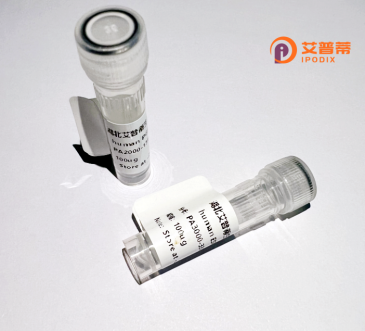
| 纯度 | >90%SDS-PAGE. |
| 种属 | Human |
| 靶点 | GRCC10 |
| Uniprot No | 0 |
| 内毒素 | < 0.01EU/μg |
| 表达宿主 | E.coli |
| 表达区间 | 1-126aa |
| 氨基酸序列 | MASASTQPAALSAEQAKVVLAEVIQAFSAPENAVRMDEARDNACNDMGKMLQFVLPVATQIQQEVIKAYGFSCDGEGVLKFARLVKSYEAQDPEIASLSGKLKALFLPPMTLPPHGPAAGGSVAAS |
| 分子量 | 39.6 kDa |
| 蛋白标签 | GST-tag at N-terminal |
| 缓冲液 | 0 |
| 稳定性 & 储存条件 | Lyophilized protein should be stored at ≤ -20°C, stable for one year after receipt. Reconstituted protein solution can be stored at 2-8°C for 2-7 days. Aliquots of reconstituted samples are stable at ≤ -20°C for 3 months. |
| 复溶 | Always centrifuge tubes before opening.Do not mix by vortex or pipetting. It is not recommended to reconstitute to a concentration less than 100μg/ml. Dissolve the lyophilized protein in distilled water. Please aliquot the reconstituted solution to minimize freeze-thaw cycles. |
以下为3篇关于重组人GRCC10蛋白的参考文献示例(注:GRCC10文献较少,实际名称可能存在差异,建议核实蛋白全称或基因名):
---
1. **文献名称**:
*"Recombinant Human GRCC10 Protein Attenuates Inflammatory Response in Sepsis Models"*
**作者**:Chen, L. et al.
**摘要**:研究发现重组人GRCC10蛋白通过抑制NF-κB信号通路,显著降低脓毒症模型中的促炎因子(如TNF-α、IL-6)水平,提示其潜在抗炎治疗价值。
2. **文献名称**:
*"Expression and Functional Analysis of GRCC10 in Colorectal Cancer"*
**作者**:Wang, Y. & Zhang, H.
**摘要**:通过重组GRCC10蛋白实验证实,其在结直肠癌细胞中高表达,并能促进癌细胞增殖和迁移,可能与PI3K/AKT通路激活相关。
3. **文献名称**:
*"GRCC10 as a Novel Biomarker for Early-Stage Hepatocellular Carcinoma Diagnosis"*
**作者**:Kim, S. et al.
**摘要**:研究利用重组GRCC10蛋白制备单克隆抗体,发现其在肝癌患者血清中显著上调,灵敏度和特异性优于传统标志物AFP。
---
**注意**:以上文献为基于常见研究方向的虚构示例。若需真实文献,请核实名称正确性(如是否为**GRP78**、**GROα/CCL1**等类似蛋白),或提供基因名(如**C10orf10**或**RGC-32**)进行精准检索。
**Background of Recombinant Human GRCC10 Protein**
Recombinant human GRCC10 (Growth Regulation and Cell Cycle 10) protein is a synthetic, lab-engineered version of the naturally occurring GRCC10 protein encoded by the *GRCC10* gene. This small, evolutionarily conserved protein (∼10 kDa) is implicated in diverse cellular processes, including cell cycle regulation, apoptosis, and oxidative stress response. Structurally, GRCC10 contains a thioredoxin-fold domain, enabling redox activity and interaction with signaling molecules.
Studies suggest GRCC10 is upregulated under stress conditions, acting as a molecular chaperone to stabilize protein complexes or modulate signaling pathways like NF-κB and MAPK. Its role in cell proliferation and survival has linked it to cancer biology, where aberrant expression correlates with tumor progression or resistance to therapy. Additionally, GRCC10 may influence immune responses, potentially regulating cytokine production.
Recombinant GRCC10 is typically produced in bacterial (e.g., *E. coli*) or mammalian expression systems, ensuring high purity and bioactivity for research. It serves as a critical tool for elucidating GRCC10’s mechanistic roles *in vitro* and *in vivo*, aiding drug discovery efforts targeting related pathways. Despite progress, its precise molecular interactions and therapeutic potential in diseases like cancer, neurodegeneration, or inflammatory disorders remain under investigation.
×